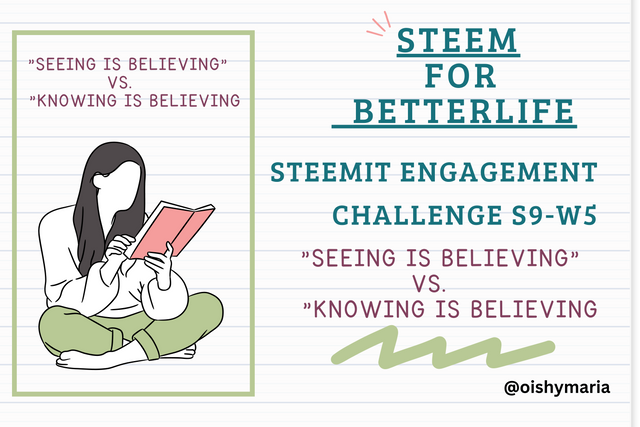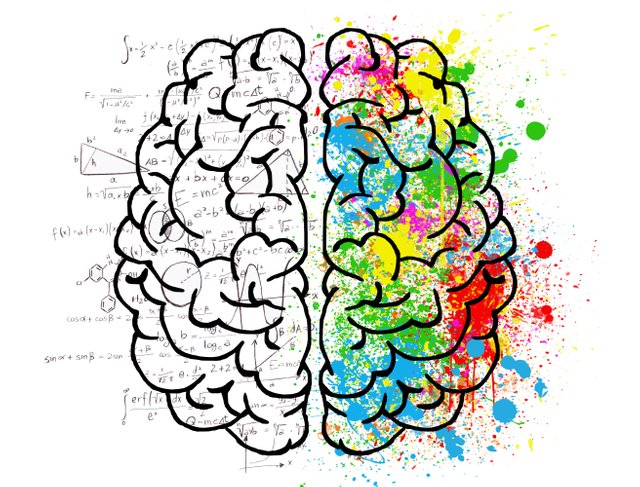
photo edit by canva
Hello, my name is @oishymaria, and I'm from Bangladesh. How are all of you doing? I wish you the greatest of luck. By the grace of God, I am also in good health.
"Seeing is Believing" vs. "Knowing is Believing" |
|---|
The idioms "Seeing is Believing" and "Knowing is Believing" are two distinct phrases that communicate meanings that are just slightly dissimilar to one another.
The famous saying "Seeing is Believing" alludes to the fact that it is simpler to believe anything when one can see it with their own eyes. It emphasizes that depending exclusively on hearsay or descriptions is typically less persuasive than relying on visual evidence or experience gained directly. This idiom is frequently used to convey a sense of skepticism or emphasize the importance of providing actual proof.
Conversely, the proverb "Knowing is Believing" implies that after a person has acquired information or comprehended a topic, they are more inclined to believe in it. This expression suggests that having trustworthy knowledge or a comprehensive understanding of a topic makes it simpler to trust whatever you consider putting your belief or confidence in. It strongly emphasizes information and comprehension's influence in forming one's opinions.
Example of "Seeing is Believing" vs. "Knowing is Believing" |
|---|
Sure! The following are some examples that demonstrate the distinction between the proverbs "Seeing is Believing" and "Knowing is Believing":

Source pixabay
Imagine someone has told you about a magic trick in which someone can levitate mid-air. You have to see it to believe it. Before you know the trick, you might be reluctant to accept it and find it difficult to suspend your disbelief. Because "seeing is believing," it is essential that you see the levitation for yourself before you can have faith in it.

Source pixabay
you are studying a complex scientific topic, like the theory of relativity, and you conclude that knowledge is equivalent to believing. At first, the ideas presented in the approach will be challenging to grasp and acknowledge as valid. On the other hand, your expertise and comprehension of the theory will grow to a greater depth as you better get the mathematical equations, become familiar with the empirical data that supports the idea, and so on. The more you learn and comprehend, the more likely it is that you will, in time, come to accept the validity of the notion. The adage "knowledge is believing" applies in this situation since your level of knowledge and comprehension affects your beliefs.
Finding Balance: Appreciating the Interplay Between “Seeing is believing” and “Knowing is Believing” |
|---|

Source pixabay
The idioms "Seeing is Believing" and "Knowing is Believing" offer two distinct takes on concluding something as important as a belief. These ideas, which at first glance may appear to be in opposition to one another, are engaged in a nuanced debate that, when properly understood, may lead to a more profound comprehension of the reality in which we find ourselves. Let's investigate how balancing these concepts might improve our perception and understanding.
The adage "Seeing is Believing" recognizes the significance of firsthand experience and the power of observation. The experience of seeing or experiencing something with our own eyes or senses has a significant bearing on our beliefs. This idea is most frequently connected to material or observable evidence that may immediately persuade us of the integrity of something. It is founded on the principle that one's own experiences may be an influential driving force in forming one's views.
Conversely, "Knowing is Believing" draws attention to the significance of information, knowledge, and intellectual comprehension in developing our views. It acknowledges that the basis of our beliefs is not just based on what we can see but also on the extent of our comprehension and the evidence that backs up this understanding. It indicates that increasing one's level of knowledge, engaging with a variety of viewpoints, and critically assessing information all help to develop a belief system that is more informed and complex.
It is essential to establish a middle ground between these two schools of thought rather than seeing them as competing ideologies. Understanding the reciprocal relationship between the adages "Seeing is Believing" and "Knowing is Believing" enables us to build a belief formation strategy that is more all-encompassing.
For instance, consider a scientific experiment. In the beginning, we could notice certain phenomena and find them intriguing; yet, if we have a firm knowledge of the fundamental principles behind the event, our belief in the phenomenon might be unrestricted. Nevertheless, as we acquire a better understanding of scientific explanations, investigate the evidence, and comprehend the theories underpinning it, our conviction becomes more firmly rooted in knowledge. In this instance, visual evidence and firsthand knowledge contribute to forming a more solid belief system.
Similarly, direct experience is critical in issues about one's personal development and sense of self-belief. It is easier to have faith in our skills when we put that faith into action when we push ourselves outside of our comfort zones, and when we see the results of our efforts. On the other hand, this conviction is strengthened even further when we learn new information, seek the assistance of experts in the subject, and obtain new insights from those people.
When we accept the ideas that "Seeing is Believing" and "Knowing is Believing," we can better comprehend the world around us. It enables us to acknowledge the relevance of firsthand experiences while simultaneously recognizing the significance of information, critical thinking, and the pursuit of one's intellectual curiosities. Finding a happy medium between these two points of view helps us build well-rounded ideas founded on scientific facts and careful consideration of the topic.
Rather than considering the phrases "Seeing is Believing" and "Knowing is Believing" as competing ideas, we should recognize how they interact. We can cultivate a belief system that is both more extensive and more informed if we can discover a way to strike a balance between our direct experiences and our intellectual knowledge. By taking such a comprehensive perspective, we can traverse the world with a sense of wonder, the openness of mind, and more profound respect for the complexity of belief creation.




You have understood very well the meaning of this sentence "seeing is believing" vs "knowing is believing" and explained it in a very logical way.
Congratulations.
@sur-riti sir
Thank you
This post has been upvoted through Steemcurator09.
Team Newcomer- Curation Guidelines for APRIL 2023
Curated by - @tocho2
@tocho2 sir
Thanks for read My post and upvoteing.
Your love and support motivates me to move forward.
@steemcurator09 sir
Thanks for read My post and upvoteing.
Your love and support motivates me to move forward.
https://twitter.com/oishymarketer/status/1658847523618844676?t=qLqIcXC2ypp7Qm-rwPT6Yw&s=19